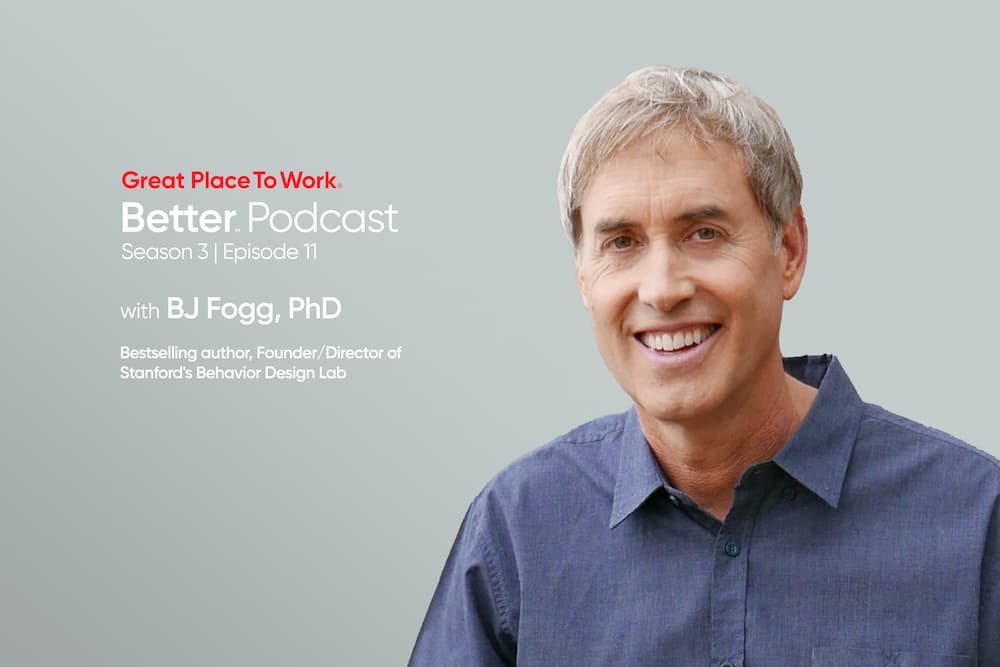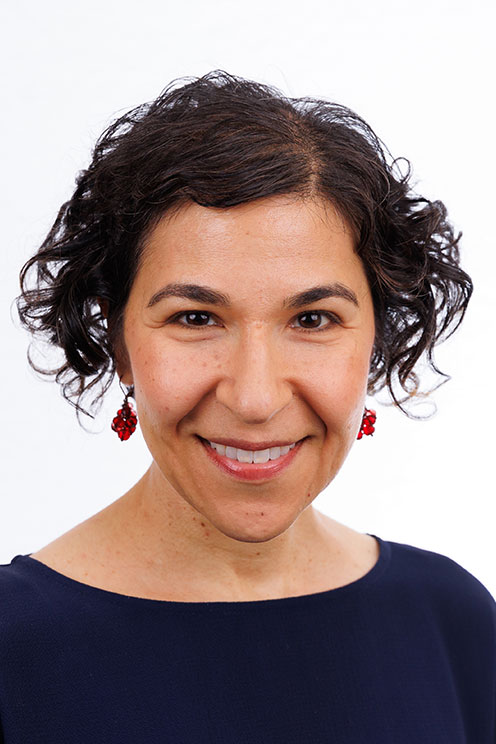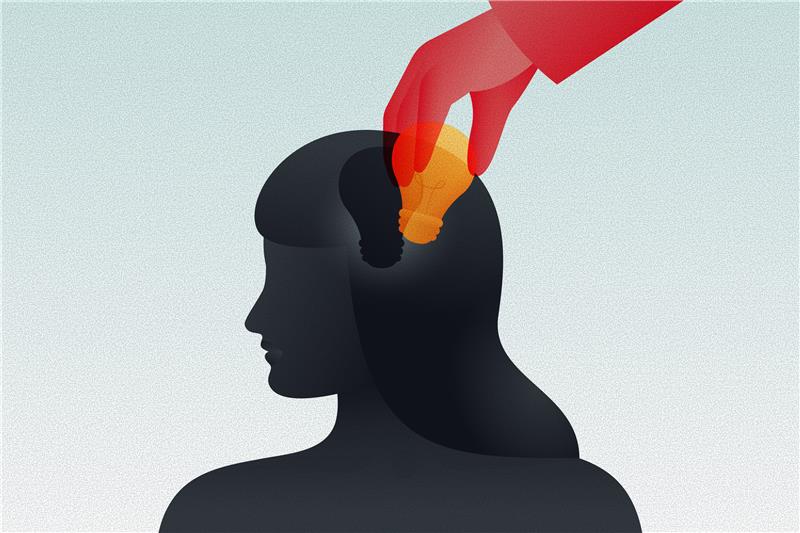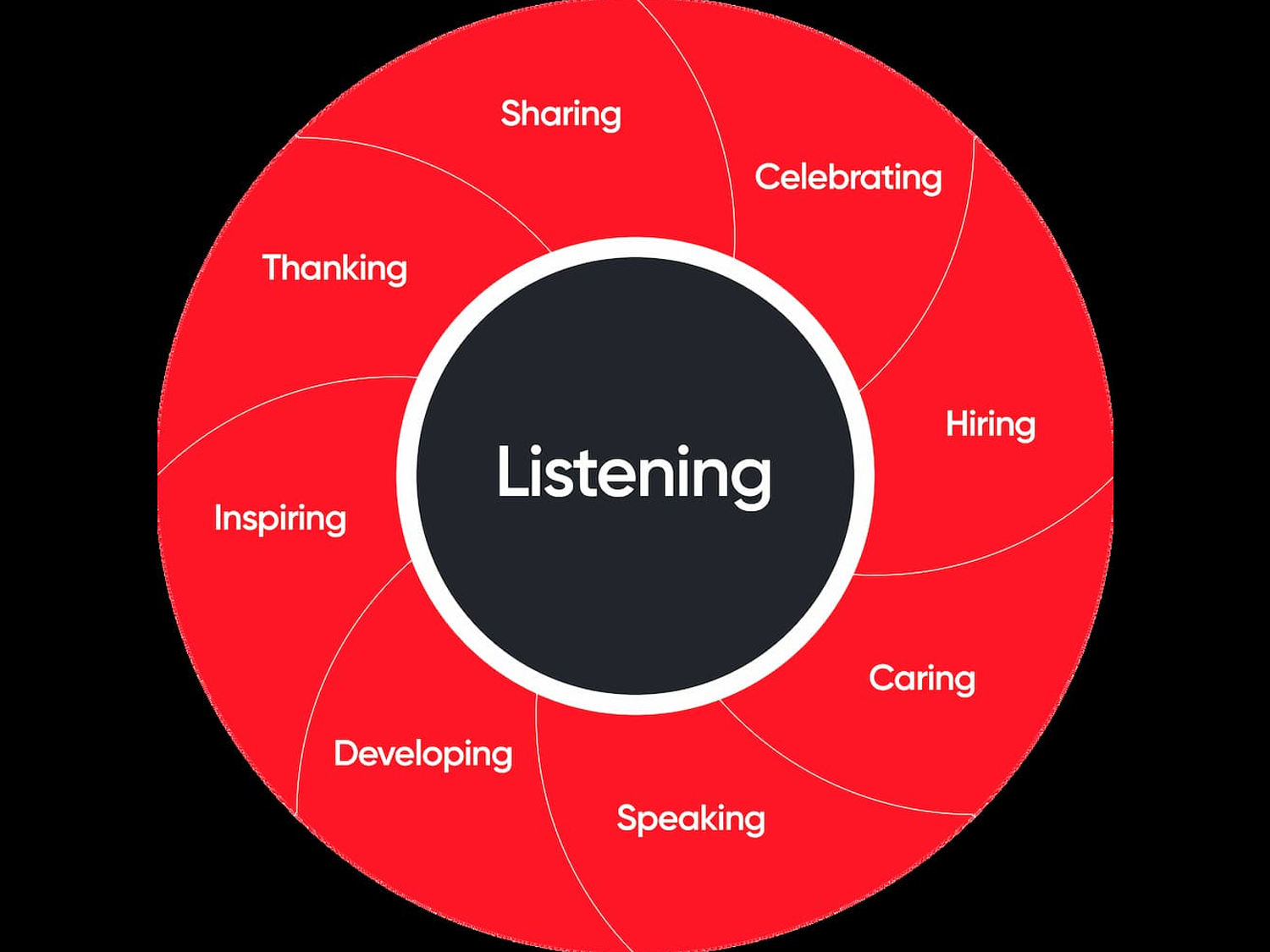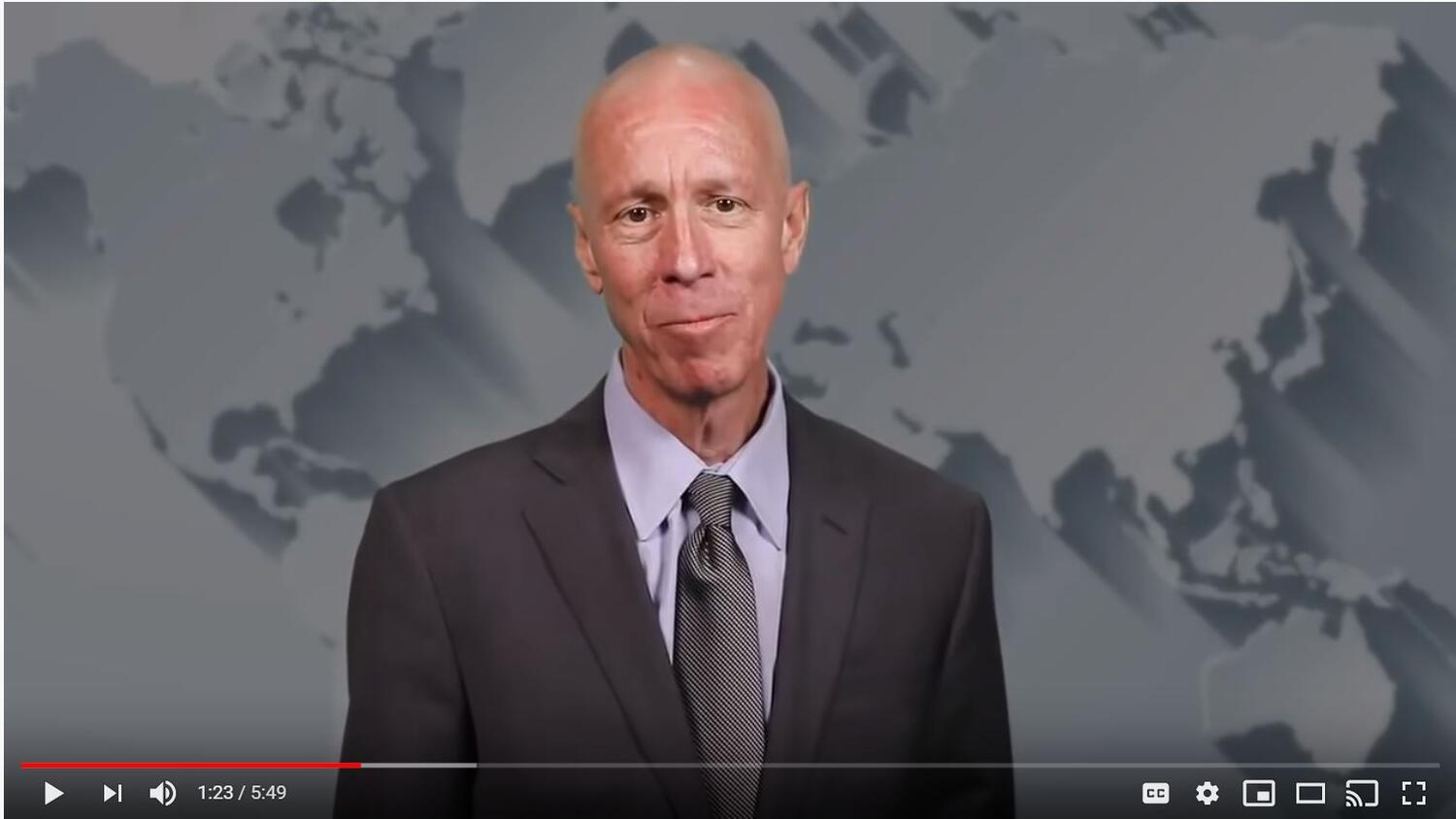Employee Experience, Employee Listening, High-trust leadership, Leadership & Management, Listening
On this episode of the Better podcast, Dr. BJ Fogg, founder and director of Stanford's Behavior Design Lab, and author of The New York Times bestseller, “Tiny Habits,” talks about how to change behavior in the workplace.
He applies his behavior model to common workplace scenarios like listening better, making time to meet with your people, and persuading your boss to sign-off on a culture initiative.
He shares his favorite habits, and the No. 1 habit he recommends we all start today.
On what’s required for behavior change:
All behavior, including habits, which is a type of behavior, happens when there's motivation, ability, and a prompt. Those are the three components that come together.
It's kind of like fire needs three things. With fire, you need fuel, you need air, and you need a spark. If you're missing any of those things, the fire will not happen. And that's how to think about the behavior model.
On how leaders can become better listeners:
Listening is not a behavior. It’s more abstract, and so I call it an aspiration. There are behaviors that you do that will lead to better listening, and that's what you need to figure out.
Maybe one habit is after somebody shares something personal about themselves, I will say—and this is the habit, "That's interesting, tell me more." Then that is a behavior. That is a behavior you can turn into a habit.
At Stanford with my students, I ask a question and if nobody speaks up, there's this time of nervousness and you want to fill the space, but the habit is to just let it be empty and let them respond.
In the Tiny Habits method, what you do is you find the best ones for you. And that's a combination of number one, will it be impactful? Will it be effective at, in this case, helping me become a good listener in the workplace?
And number two, is it something I can get myself to do? Can I get myself to, at the beginning of every meeting, do some sort of check-in where I listen? Can I get myself to actually pause for a few seconds after I ask a question? It’s that combination—what's going to be effective and what can I get myself to do.
On how to get a leader to commit to culture work:
You're not trying to get the CEO to create a habit. You're trying to get the CEO to make a decision or to approve something, which is a one-time action. That's a different project than designing for a habit. Now, both habits and one-time actions will come down to motivation, ability, and prompt, because they're behaviors.
The best way to persuade is a combination of narrative and data. Tell a very compelling story or have them consume a very compelling story. TED Talks do this very well. It might be a TED Talk, it might be somebody from another company, it might be somebody within the company.
And also data. Here's what the data shows. Those work differently in people's brains and both of them can be very persuasive, and together they're very powerful. Present narrative and data. and then the behavior you want, and make it really easy to do.
On helping busy managers find time to check-in with their people:
Even though you may have a check-in that's a 30-minute meeting, scale it back and say, "What is the simplest thing I can do with the most impact?" It might be sending a text, sending an emoji, a five-minute chat on the way home, in the car or something like that.
Here’s why: The easier, simpler behavior, the less motivation it takes to do the behavior. So if your motivation is going out to other things in the moment, if something's really easy to do, you can still do it. If something's hard, like it takes an hour or it takes a lot of thinking or a lot of creativity, then when your motivation sags, you don't do it.
On his favorite habit:
One is first thing in the morning, and I've named this the Maui Habit, and I even gave a TED Talk on it, is as soon as your feet touch the floor in the morning and you’re getting out of bed, you say, "It's going to be a great day." It really improves your morning, your day, your week, your life, and so on.
Another great time to put in habit is after you turn on the shower and you're waiting for it to get warm, you can have a moment of gratitude. For me, the practice is gratitude around some aspect of my body and I try to look for really unusual ones. One of my friends started doing pull-ups. He put a pull-up bar in his bathroom and would do at least one pull-up.
The expectation in the Tiny Habits method is, "I'll do at least one, and if I want to do more, I'll do more." And he got stronger and started doing a lot more, and he was so happy about that. And it was in those few seconds when you're waiting for the shower to warm up, you do something and the consistency pays off over time.
Subscribe to Better wherever podcasts are available so you don't miss an episode.
Get more insights
Learn more strategies from our workplace culture experts at our For All™ Summit, April 8-10, 2025 in Las Vegas, NV.
Stanford’s BJ Fogg on Behavior Change and How to Listen Better at Work
Roula Amire:
Welcome to Better by Great Place To Work, the global authority on workplace culture. I'm your host, Roula Amire, content director at Great Place To Work. Today we're talking about behavior change in the workplace, and I can't think of a better guest to have on than Dr. BJ Fogg, founder and director of Stanford's Design Lab, and author of the best-selling book, Tiny Habits. I asked BJ to apply his behavior model to common workplace scenarios like listening better and making time to meet with your people. He also shares his favorite habit, which has quickly become one of mine. I hope you'll enjoy this episode. That does it for season three, but we'll be back later this fall with season four. If you've enjoyed what you've heard, hit that subscribe button and give us five stars.
Here's BJ. Enjoy. BJ Fogg, welcome to the podcast. You're our first behavior scientist to appear on the show, and that's very exciting because we certainly love research and researchers and data at Great Place To Work. I know you're primarily a researcher, but you're also an adjunct professor, and I have a soft spot for professors because that's what both my parents were. So I'm doubly happy to have you on today. Thanks so much for joining.
Dr. BJ Fogg:
Well, thank you for inviting me, Roula.
Roula Amire:
Today we're going to talk about behavior change in the workplace, and this is something our audience is always working to do, which is improve culture and the employee experience. And there's no better person to ask than you. You're the founder and director of Stanford's Behavior Design Lab. You've studied behavior for more than 20 years and are the New York Times bestselling author of Tiny Habits: The Small Changes That Change Everything. In your book, you outline your behavior model, which is based on the premise that behavior is driven by three things, motivation, ability, and prompts. And by designing habits that align with those three elements, we can create lasting change. And those habits should be small and achievable as opposed to overwhelming ourselves with big drastic changes. Before I get into my first question, do I have that right so far?
Dr. BJ Fogg:
Yes, that's the essence. All behavior, including habits, which is a type of behavior, it's a subset, happen when there's, like you said, motivation, ability, and a prompt, something that says, do this now. Those are the three components that come together. Let me give a kind of quick analogy here that I don't use often. It's kind of like fire needs three things. With fire you need fuel, you need air, and you need a spark. And if you're missing any of those things, the fire will not happen. And that's how to think about the behavior model. It's motivation, ability, and a prompt.
Roula Amire:
Okay, great. So let's run through a few workplace scenarios and apply your model. Our 30 years of research at Great Place To Work has shown that trust is the foundation of great cultures. It's the cornerstone, it's the through line. Trust is built on fairness, credibility, and respect over time. We've also identified nine leadership behaviors that can help build or break that trust. And out of the nine, the most important behavior is listening. So if you can't listen well, you can't lead well. And if you're not a great listener, then you can't model all the other eight behaviors well. But listening is the behavior most leaders aren't trained well for, and frankly most people, we're not great listeners. We're not really setting aside our opinions and our assumptions and considering someone else's point of view. And leaders especially, they're trained to do.
So let's assume a leader, or anyone in the workplace, understands the importance of listening and they want to be a better listener. They want to help build that trust in their workplace. They want to listen to more people on their team and more importantly people not on their team. So using your model, how can they prioritize listening and get better at it?
Dr. BJ Fogg:
It's a great starting point. For something like listening or other things that people aspire to get more sleep or be more productive, those I would consider aspirations and not behaviors. So listening is not a behavior, it is a general class. It's more abstract, and so I call it an aspiration. There are behaviors that you do that will lead to better listening, and that's what you got to figure out, what are the specific habits that I do? Maybe one habit is after somebody shares something personal about themselves, I will say, and this is the habit, "That's interesting, tell me more." So that exact phrase, "That's interesting, tell me more." Then that is a behavior. That is a behavior you can turn into a habit.
So it's great, and I'm so glad you have the nine leadership areas and listening is important, but the specific behaviors need to be surfaced, and there are different listening behaviors. There's probably, I'm going to guess, 50 different specific things you could do. There's probably not 500, and there's more than five. There's a lot, let's say. So you've got to figure out which specific ones, and then you design those into habits. That's a big part of the Tiny Habits method and my work is help people go from this abstract aspiration, like listening, and then figure out what are the specific behaviors that I want to turn into habits.
Roula Amire:
So most managers or leaders, they'll have a check-in or they should, have a meeting with their person they're managing. How do they then find time to listen in that meeting? How would you break that down? Or is it what you mentioned before, when someone says something, ask them a question, I say, "That's interesting," and then I pause and wait for their answer? Or do they get in the habit of, I start every meeting saying, "How are you?" And then I'm going to stop talking?
Dr. BJ Fogg:
Yeah. Right there you mentioned two more specific behaviors that could be habits. One is, "How are you?" start the meeting. The other is after you ask a question, pause, and let the silence happen and so on. So there's, like I said, probably 50 different actions/behaviors that you could turn into habits. And that's what you've really got to do is you've got to figure out which ones do you want to bring into your life of these 50, which ones are a good fit for you, which ones are going to be effective? And I don't have that list for listening. I can kind of come up with some. But that's an important part of, I think this project and for people that want to be leaders and good managers is to explore. It's like, what are the specific actions/behaviors, I'm using those as synonyms right now, that I want to bring into my life and turn into habits?
To go to your question, how do you fit it into a busy schedule? Some of them don't take that long. It could be just, like you said, after I ask a question, I do this at Stanford with my students because I don't have big interviews with my students, but I ask a question and if nobody speaks up, yeah, there's this time of nervousness and you want to fill the space, but the habit is to just let it be empty and let them respond. And so I think the example you gave is a really good one and there are 49 others that people could look at. And yeah, you're not going to create all the habits at once. So in the Tiny Habits method, what you do is you find the best ones for you. And that's a combination of number one, will it be impactful?
Will it be effective at, in this case, helping me become a good listener in the workplace? And number two, is it something I can get myself to do? Can I get myself to do, at the beginning of every meeting, some sort of check-in where I listen? Can I get myself to actually pause for a few seconds after I ask a question? And so it's that combination, what's going to be effective? What can I get myself to do? And then from the set of let's say 50 listening actions, then you can move some of those forward and habits.
Roula Amire:
And in terms of prompts, I'm just remembering, I believe I've heard our CEO say he has a sign on his desk that says, "Talk less." Is that considered a prompt? So it's a reminder, because he is always working to become a better listener, become a better leader, listen more, talk less. Is that a prompt in your world or no?
Dr. BJ Fogg:
Short answer is no, and here's why. I like that. I like that, that's an aspiration, listen more. So the behavior model that we're working from in Tiny Habits is, behavior happens when motivation, ability and prompt come together. Listen more is not a behavior, it's still abstract. If it's, "Pause for three seconds after I ask a question," if that was the sign, then I would say, "Yeah, that's a prompt," because it's prompting a behavior. I mean I do like that sign, I do like those kinds of aspirations around us reminding us. But the challenging thing is what does not work is to try to motivate yourself or others toward an abstraction. So let's pick a different one, like, "No, it's really important for me to communicate better." Communicate better. I'm picking something even more abstract and trying to motivate yourself like, "Okay, today for sure I'm going to communicate better," or trying to get employees to communicate better and I'm going to give you a prize for communicating better.
That is a typical approach that doesn't work very well is trying to motivate something abstract. So instead what you do, you take the abstraction and you make it specific and you make it easy to do. Remember there's motivation, ability, prompt. If you are very specific, then the next thing isn't trying to motivate, that is, "How do I make this really easy to do?" And then the next thing is, "What's going to prompt me to do this?" So in the best of worlds for designing, and then when I say best of, this is how we should approach it. It's not about motivating something abstract, it's like getting specific. And then the ability part means, how do I make it easy and then prompt, at what moment do I do this? What is the thing that causes me to say this or to pause and so on?
Roula Amire:
Based on your model, we also know that knowledge alone, just simply knowing something is good for us isn't enough to change our behavior, which is as we've been discussing. So we know exercise is good for us, but it's not enough to make us exercise every day. We know scrolling our phones at night is not good for us, but that doesn't always stop us from doing it. So in terms of the workplace, our research shows that high-trust cultures lead to better business. So this is overwhelmingly true. Productivity, profitability, wellbeing, retention, innovation, all those levels are significantly better at companies with great cultures compared to the average. Those are the facts. Despite that many leaders don't make culture a priority. They say, "Culture work takes time from growing the business. It's a nice to have, it's not a priority." And we see the result. Most people aren't having a great time at work, they're not having a positive experience.
Productivity and engagement levels, all those are really low. So if you're an HR professional who comes armed with this data to show that culture work will help their CEO get them the business results they're after and you want to get them to prioritize culture, how would you advise them? I can give a specific example. Even, let's say they want to build trust and they say, "Hey, you should be more visible to our employees. You should make time. I really recommend you hold monthly or quarterly town hall meetings where employees can see you, hear from you, ask you questions." That's kind of how we're defining just one small example of culture work. That's worth their time, but from the HR perspective, we believe certainly that's worth their time because that helps build trust and trust leads to all those great business results.
Dr. BJ Fogg:
I call my work behavior design and a subset of that is Tiny Habits, but it's all built on the behavior model. So I do have an approach here for you. It is a very hard question and I'm so glad you asked it. Notice what's going on here is you're not trying to get the CEO to create a habit. You're trying to get the CEO to make a decision or to approve something, this is a one-time action. You're trying to get compliance, a thumbs up, something along those lines, put some resources, this direction and so on. Notice that's a different project than designing for a habit. So I'm going to back up a little bit and give a very brief model that is not in my book, I so wish it was, but here it is. Draw a big circle and that big circle put the label on behavior. Inside that circle of behavior, you have a smaller circle called habits. These are a subset, but these are things you do quite automatically. Then you have a different smaller circle that are one time actions.
That's what we're talking about here. Now, both habits and one-time actions will come down to motivation, ability, and prompt, because they're behaviors, they're in that bigger circle of behavior. So now we're talking about how do we get the CEO to say yes to funding this or giving a talk or whatever that is. I would, number one, have very clearly in mind what you want the CEO to do. We want them to allocate budget or time or hire somebody or whatever, have that very clearly in mind. And then, because now you got to know what you're shooting for here, we want them to say yes to X or approve Y. Then in this case, if the CEO is not inclined or the leader is not inclined to do it, now you've got to persuade them. Okay, that's different than creating habits, but in my view, the best way to persuade is a combination of narrative and data. Those are two ends of the...
Tell a very compelling story or show or have them consume in some way a very compelling story. And TED Talks do this very well. It might be a TED Talk, it might be somebody from another company, it might be somebody within the company. And also data. Here's what the data shows. Those work differently in people's brains and both of them can be very persuasive and together they're very powerful. So I would present narrative and data and then the behavior you want, make it really, really easy to do, okay? And you might have to just baby step it. Maybe there's a budget you want approved and that's the result of doing other things. So maybe you get the CEO to say yes to a 30-minute meeting to talk about the potential for X, Y, Z. So that would be the specific step that could lead to getting the budget, for example. So be clear what you want, then go upstream or make it small and easy. Make it really easy for them to say yes to it. That's the approach I would take here.
Roula Amire:
I admit that's the million-dollar question. How can you convince the leader to believe culture should be the top priority? Another thing we hear is, so the middle managers, they have a lot on their plates, they're strapped for time. What would you tell those busy managers who want to meet more regularly with their people, how can they "make that happen"? Even they put it on the calendar, it might not necessarily happen.
Dr. BJ Fogg:
You are so good at asking tough questions, thank you so much. We all can relate to this because there's many, many things we'd like to do, but they are competing. We have competing priorities. If this is really a priority for middle managers, and it may not be, sometimes you just say, "Guess what? That wasn't a priority and I'm okay with that." Our motivation shifts around at different times, but if it's like, "No, I really should be doing this, it's a priority a lot of the times for me," I would try to find out what is the simplest thing you can do with the biggest impact as a middle manager? And I call that approach The Feather Principle. What is the simplest thing with the biggest impact? And really search for that. And it might mean asking other people, asking your friends, asking colleagues, asking outside the company, what is the simplest thing you do in order to, and Roula was it to check in with your direct reports? Is that-
Roula Amire:
Yeah, to make time to meet with them and they're always too busy.
Dr. BJ Fogg:
It might be sending a text, sending an emoji, a five-minute chat on the way home, in the car or something like that. Even though you may have a way to check in that's a 30-minute meeting, scale it back and say, "What is the simplest thing I can do with the most impact?" And here's why, the easier, the simpler behavior, the less motivation it takes to do the behavior, and that's what my behavior model shows in part is the easier the behavior, less motivation. So if your motivation is going out to other things in the moment, if something's really easy, super easy to do, you can still do it. If something's hard, like it takes an hour or it takes a lot of thinking or a lot of creativity, then when your motivation sags, you don't do it. You're below the action line.
I'm drawing it in the air here. There's a two-dimensional graphic that captures this model about all behavior and it shows that one of the ways to get a behavior to happen reliably is to make it really easy to do because then it's not so dependent on high levels of motivation. So that's what I would search for, what is the simplest thing with the biggest impact? I'll give a quick example from my own personal life. I call my parents once a day and I keep it. There's a couple of things. So I know when it happens in my routine, I know what the prompt is. When I'm living in Maui, it's one thing, when I'm in California, it's a different prompt, but I know when it happens. And in my mind, I don't have to have a huge conversation with them. Gretchen Rubin and her sister, I took this from them and I just loved it.
They said, "It's okay to be boring with our family members," so that makes it easier. I don't have to have anything great to talk about with my parents. It's okay to be boring. I say that to myself, so that makes it easier. And then also I can keep it really short. I called my mom yesterday and it was like 90 seconds and that's all, which is on the shorter side, but it was... But just calling her and saying, "Hi mom, how you doing? What's going on? What are you looking forward to?" Say, "Great mom, I'll talk to you tomorrow. Bye." That helps me stay connected with her and it helps her know that I'm thinking about her. And other times we'll have longer conversations. So that's what I would search for within the workplace and the people you work with, what's the smallest thing with the biggest impact? For reasons I just explained.
Roula Amire:
Our CO said recently, "There's our research that showed actually the impact of meeting 15 minutes a day with the leader and Gen Z or millennials, so the younger generation, that can transform their work experience all to the positive." If a leader is checked in for 15 minutes a day with the younger generation every day, their answers to all those questions is they're fantastic, and that's 15 minutes and that's transformational.
Dr. BJ Fogg:
I teach young people at Stanford and that kind of attention and consistency is probably something they've rarely had in their lives. So you're going to become one of the favorite people in their lives. One thing I did this year with my students, and I have a lot of students, was I basically required all of them to book a 15-minute appointment with me within the first 10 days of the quarter, which took hours off my schedule, but guess what? What a great investment that was.
Roula Amire:
Did the majority, if not everyone, do that?
Dr. BJ Fogg:
Every single person did it, every single person. And it just set the class in the right direction. I got to know the students better. I was able to customize my teaching better. They felt heard and seen very early on in the experience. I did that because last fall I didn't do that. I had a big class and it wasn't till the end of class, I really started connecting with them and I was like, "That was a big mistake." So as hard as it sounded like all these hours I'm booking up my calendar for, it was really great investment, I'm going to do it with every single class.
Roula Amire: Is that habit then?
Dr. BJ Fogg:
Ooh, what a good question. Yes. And let me give a distinction here. I would call that a cue habit versus a cycle habit. So this is not in my Tiny Habits book. There was just so much that I couldn't put in the book, but there's a lot in the book, but this is not. Let's start with this. A cycle habit is something you do on a regular cycle, like you start your coffee maker, you brush your teeth, you do it on a regular and there's weekly cycles and there are some monthly cycles. Those are a little bit harder. But then you have cue habits. Those happen in response to a need, like your phone rings, you pick it up, you want to buy a book, you go somewhere online and probably buy it and so on. Notice those aren't cycle habits, there's a cue.
So I would look at what I did with my students and the fact that it got such an emotional payoff for me, and it's the emotion that helps create the habit, it's not repetition. So I had this great emotional payoff. So that will become a cue habit. After I design my next syllabus for my next course, I will put on there, "Book a time with me," and I'll do the work so they can go to my calendar and get on my schedule and so on. Now you could also say that's a routine or a practice. Those words are all kind of abstract and overlapping. I don't care what we call it, but it's something that you do on a regular basis and the key to habit, without thinking very much. So I'm not going to be deciding in the future, do I do these calls or not do these calls, I'm doing them.
Roula Amire:
You're doing them.
Dr. BJ Fogg:
And then I would put that in the category of habit versus decision. So if you're making a decision about something, that's the other end of the spectrum, that's not a habit if you're deciding and deliberating.
Roula Amire:
Do you have a favorite habit, something we can all benefit from?
Dr. BJ Fogg:
Yes. Let me share a few, I have a lot. One is first thing in the morning, and I've named this the Maui Habit, and I even gave a TED Talk on it, I think it's so important, is as soon as your feet touch the floor in the morning, you're getting out of bed, say, "It's going to be a great day," those seven words, it's going to be a great day. Y'all try it, okay? I mean, I could tell you why and da, da, da, but just try it. It really improves your morning, your day, your week, your life, and so on. If you don't believe it's going to be a great day, like it's going to be hard or challenging, still say it. It was a couple of weeks ago, I was like, "It's going to be a great day somehow." And so I would say about a fifth of the time, I'm like, [inaudible 00:23:54], but it works. Next, I love the habit where I do pushups after I pee because I've gotten so much stronger from it.
Now I only do it at home. I don't do it at Stanford and I don't do it if... I used to do it in hotel rooms and I thought about it and changed my mind. So that habit, right after you pee, that can be a reminder to do something. And so for me, it has been pushups. And then I was doing a ton of pushups actually over the course of a day because making it easy is two pushups, but you can do more if you want to. I do 20 or 25 and go, "Yeah, I'm knocking out of the park." And then I started getting an elbow issue. So then I switched to really deep squats. So I'm still doing the deep squats. So I guess that thing, that moment after you pee is a great moment to build in a habit, find out what works for you and take advantage of that opportunity right after you pee. It could be either before or after you wash your hands, it doesn't matter. It depends what you're doing.
Roula Amire:
Or I heard you talk about... When I first discovered you by hearing you on Armchair Expert. So now you're reminding me. I think you also said on that episode, which was quite a while ago, the minute or two before a shower.
Dr. BJ Fogg:
The gratitude, warming up the shower. Yeah, after I turn on the shower. So notice the way I'm phrasing it is, after I, I will. So after I turn on the coffee maker, I will do a stretch on the counter. After I turn on the coffee maker, I will text my mom. So you can insert the habit after an existing routine. Another great time to put in habit is after you turn on the shower and you're waiting for it to get warm, you can have a moment of gratitude. For me, the practice is gratitude around some aspect of my body and I try to look for really unusual ones.
One of my friends who's a VC in Silicon Valley started doing pull-ups. He put a pull-up bar in his bathroom and would do at least one pull-up, set the bar low. I don't mean the pull-up bar, but your expectation in the Tiny Habits method is like, "I'll do at least one, and if I want to do more, I'll do more." And he got stronger and started doing a lot more and he was so happy about that. And all it was was those few seconds you have when you're waiting for the shower to warm up, you do something and the consistency pays off over time.
Roula Amire:
Well, BJ, thank you for your time. Thanks for the conversation. I recommend everyone getting Tiny Habits. Where else can they find you, BJ, and your work?
Dr. BJ Fogg:
Bjfogg.com is the main thing within Tiny Habits, Tinyhabits.com. And if you want to see something new we're creating, and it's for kids and parents, we have songs about Tiny Habits. You go tinyhabits.com/songs. There's a set of songs there that aren't designed for kids, but parents like them too about good habits and the mindset around good habits and optimizing your life.
Roula Amire:
Excellent. Thank you for the conversation. I really enjoyed it.
Dr. BJ Fogg:
Thank you, Roula.
Roula Amire:
Thanks for listening. If you enjoyed today's podcast, please leave a five star rating, write a review, and subscribe so you don't miss an episode. You can stream this and previous episodes wherever podcasts are available.


